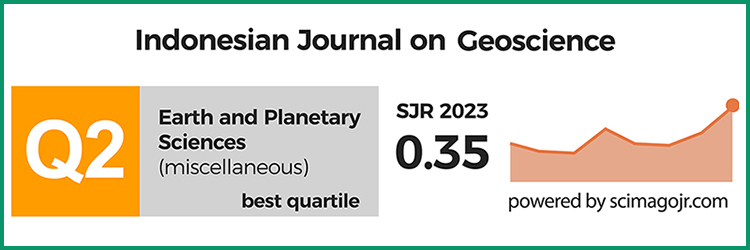Vertical Fracability Model on Lithofacies Association of Brownshale Formation from Outcrop Analog Using Rock Mechanical and Mineralogy Correlation Method: A Preliminary Study of Shale Hydrocarbon Development in Bengkalis Trough, Central Sumatra Basin
DOI:
https://doi.org/10.17014/ijog.9.1.87-104Abstract
DOI:10.17014/ijog.9.1.87-104
In the production stage of shale hydrocarbon with very low permeability, an in-depth analysis of the mechanism governing hydraulic fracking is required to open natural fractures, so that the fractures are connected to allow maximum flow of hydrocarbon fluids. This study is dedicated to create a vertical fracability model of shale hydrocarbon as a basis for planning the optimal position combination of horizontal well with multistage hydraulic fracking based on the correlation of rock mechanical and mineralogy analysis. Because in-situ core data is not available, this study uses shale core and shale sample data from outcrop analog (surface) as as a representative of the Brownshale Formation in the Central Sumatra Basin. At present, Indonesia has a very large potential for shale hydrocarbon, mainly from the Brownshale Formation of Pematang Group as the main source rock in the Central Sumatra Basin, which spread over several troughs, namely: Balam, Rangau, Kiri, Aman, and Bengkalis, where Bengkalis trough has the largest area compared to others, so it was chosen as the research target. In creating the vertical fracability model, information about the elastic rock properties, namely Young's Modulus (YM) and Poisson's ratio (PR) are needed as the basis for determining the depth interval of the formation with high fracability. Fortunately, at this time there was a very good outcrop analog at the coal mine site of PT. Karbindo in Kiliranjao, and there were also several outcrop analog locations in Limapuluh Koto area, West Sumatra. The vertical fracability model of shale hydrocarbon of the Brownshale Formation shows an interesting phenomenon, where the sweetspot fracable window interval is in the low YM - high PR zone, so it can be concluded that the low YM - high PR zone is a good candidate for hydraulic fracking. In contrast, the fracture barrier interval is in the high YM - high PR and low YM - low PR zones, where both are correlated with high Brittleness Index (BI), but the Fracability Index (FI) is low. I t can be concluded that high YM - high PR and low YM - low PR are inappropriate interval as a candidate for hydraulic fracking. This phenomenon is confirmed by the presence of a dominant carbonate mineral at the upper section as fracture barrier, while at the lower section as a sweetspot fracable window, which is more dominated by quartz mineral.



















